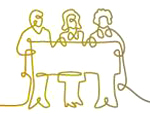Recently, I had the opportunity to work with one of the 157 local Jewish Federations on helping them remain relevant to the changing needs of their community and develop a marketing theme and materials to attract new donors. It wasn’t easy, but it was telling, and the lessons learned may be informative for other organizations grappling with change.
1. Do your homework.
Before you can address any issue, you need to know what your audience thinks — and it’s not necessarily what you expect. To determine the needs of the community, we conducted a Community Opinion Survey which asked about people’s beliefs and values, giving habits, and awareness of the Federation’s programs.
The findings were startling. Even long-time donors (who had been giving for 6 years or more), were unaware of how they had first heard of the Federation, or were able to assess the value of the federation’s programs. Don’t assume your donors know what you do, you need to educate them (not just expect annual contributions, which will slowly dissipate.
2. Address local needs.
For a local agency that also supports Jews worldwide through their allocations to the American Jewish Joint Distribution Committee (JDC) and the Jewish Agency for Israel (JAFI), people valued the programs in the local community more than helping Jews abroad or in Israel. The top values shared by the respondents included: ensuring Jewish continuity for the Jewish people, raising children with Jewish values, creating a Jewish home, doing good deeds, and being a part of a community — all things that the Federation is supporting at a local level.
3. Be flexible in your approach.
To address these needs, we presented three different message concepts, recommending one, “A voice for your values. A force for our future.” We thought that this best connected people’s personal interests and desire to do good with the collective force of the Federation. We incorporated this into an ad and brochure which we presented at the next meeting. However, in the process of creating an ad and brochure, we had trouble remembering the exact wording of the tagline — not a good sign for something that is supposed to be memorable.
And so we rescinded our original recommendation and suggested using the second concept: “The good you can see around every corner.” Agreeing that this was more memorable and accessible, the marketing committee voted to adopt this line instead. We subsequently developed an ad, brochure and presentation that uses the headline: “Why support the Jewish Federation? For the good you can see around every corner” with a panorama illustration showing all the support structures in the community, creating a memorable image of the Federation in action in the community. A willingness to be flexible resulted in a better concept.
4. Working backwards can work.
Introducing change in an organization can be challenging, and so sometimes, you need to do it through the back door. For example, we knew that changing the mission statement first would be an issue, and so instead, we used the marketing process to drive the larger change in the organization. We introduced a brand statement, that was modified and then adopted as the mission statement and asked the Executive Committee to grapple with its implications for the organization in five areas: programs and events, allocations, staffing and operations, and fundraising.
There have since been changes in staff and the agency is starting to explore how they can adapt their allocations process to new needs. Just as important, they are exploring how to better present their financials so that they are not showing a million dollar difference between their revenue and their allocations (the large difference caused by not counting their own programs in their allocations budget). As you can imagine, this requires some re-working of their operations and reporting.
5. It’s necessary to go through a process, just be clear about the process.
In this case, it involved a lot of committees, an approach for soliciting input from the community that was well entrenched at the Federation. Before we had arrived on the scene, they had formed a strategic planning committee to explore how they could adapt. This committee resulted in five task forces to address specific areas including funding, marketing, outreach and engagement, Jewish education, and senior services. With our mandate to improve their marketing, we convened a Marketing Committee comprised largely of lay people and also some key staff.
Overall, the process worked well (we had marketing professionals on the committee, so we received relevant feedback). However, when it came to making the ultimate decision about the mission statement, the process by which it would get approved was unclear, with the marketing committee, top staff, the board and the board’s Executive Committee, all having a say.
Certainly, changing an organization created in another generation, for a different set of needs, and led by an older board is a struggle. Doing so while maintaining a community-led approach makes it that much more difficult. The Federation deployed yet another committee, an Implementation Committee, to see the work through.
While we moved them along in their change process, and they are in a good position to continue making positive changes, it will be interesting to see if they can catch up with the pace of change occurring in the world.
Related Stories
 Howard Adam Levy, is Principal of Red Rooster Group, a New York based graphic design firm that creates effective brands, websites and marketing campaigns for nonprofits to increase their visibility, fundraising and communications effectiveness. Contact us at info@redroostergroup.com.
Howard Adam Levy, is Principal of Red Rooster Group, a New York based graphic design firm that creates effective brands, websites and marketing campaigns for nonprofits to increase their visibility, fundraising and communications effectiveness. Contact us at info@redroostergroup.com.This article originally appeared in eJewishPhilanthropy, January 25, 2011.
- Read more about Red Rooster Group’s work promoting Jewish organizations.
- Contact Red Rooster Group for help with your marketing.





